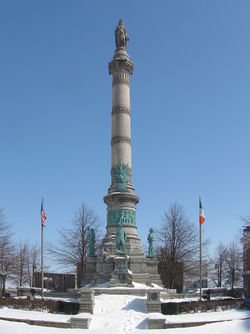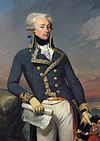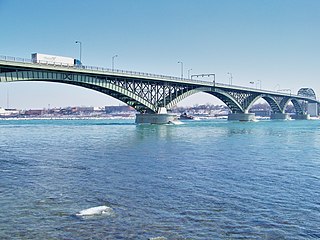
Buffalo is a city in the U.S. state of New York and the county seat of Erie County. It lies in Western New York at the eastern end of Lake Erie, at the head of the Niagara River on the Canada–United States border. With a population of 278,349 according to the 2020 census, Buffalo is the second-most populous city in New York state and the 81st-most populous city in the U.S. Buffalo and the city of Niagara Falls together make up the two-county Buffalo–Niagara Falls metropolitan area, which had an estimated population of 1.2 million in 2020, making it the 49th-largest metro area in the U.S.

North Tonawanda is a city in Niagara County, New York, United States. The population was 31,568 at the 2010 census. It is part of the Buffalo–Niagara Falls Metropolitan Statistical Area. The city is named after Tonawanda Creek, its south border.

Lockport is both a city and the town that surrounds it in Niagara County, New York, United States. The city is the Niagara county seat, with a population of 21,165 according to 2010 census figures, and an estimated population of 20,305 as of 2019.

The Niagara Frontier Transportation Authority (NFTA) is the public agency responsible for operating most public transportation services in the Buffalo–Niagara Falls metropolitan area. The NFTA, as an authority, oversees a number of subsidiaries, including the NFTA Metro bus and rail system, the Buffalo-Niagara International Airport, the Niagara Falls International Airport and NFTA Small Boat Harbor. The NFTA Metro bus and rail system is a multi-modal agency, utilizing various vehicle modes, using the brand names: NFTA Metro Bus, NFTA Metro Rail, NFTA Metrolink and NFTA PAL. In 2023, the system had a ridership of 15,429,900, or about 51,900 per weekday as of the first quarter of 2024.

Buffalo City Hall is the seat for municipal government in the City of Buffalo, New York. Located at 65 Niagara Square, the 32-story Art Deco building was completed in 1931 by Dietel, Wade & Jones.

Lafayette Square is a Buffalo Metro Rail station near City Hall and is near the center of the Buffalo Central Business District at Lafayette Square located in the 400 block of Main Street in the Free Fare Zone, which allows passengers free travel between Canalside station and Fountain Plaza station. Passengers continuing northbound past Fountain Plaza are required to have proof-of-payment. Lafayette Square station is the closest to the Buffalo & Erie County Public Library, located one block east at Washington and Clinton Streets. On February 28, 2019, The Buffalo News announced that Evans Bank, which opened its downtown headquarters in the Main-Court Building the previous October, bought the naming rights to the station for nearly $161,000 for five years and nearly $352,000 if extended to 10 years.
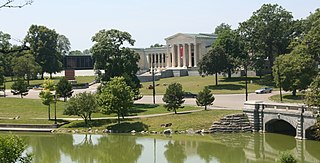
Delaware Park–Front Park System is a historic park system and national historic district in the northern and western sections of Buffalo in Erie County, New York. The park system was designed by Frederick Law Olmsted and Calvert Vaux and developed between 1868 and 1876.

New York State Route 384 (NY 384) is a state highway in Western New York in the United States. It is a north–south route extending from the city of Buffalo, Erie County to the city of Niagara Falls, Niagara County, and is one of several routes directly connecting the two cities. The southern terminus of the route is at NY 5 in downtown Buffalo. NY 384's northern terminus is at the Rainbow Bridge in downtown Niagara Falls. Through its entire course in Erie County, it is known as Delaware Avenue for the street it follows in the city. In Niagara County, NY 384 follows the Niagara River and is named River Road and Buffalo Avenue.

Since the Buffalo Metro Rail light rail was proposed in the 1970s, there have been multiple proposals for expanding the system, which is currently a single 6.4-mile (10.3 km) long line. Public officials, agencies and advocacy groups have created plans, with the most recent and extensive being an extension to the town of Amherst. Groups have formed on both sides of the issue.
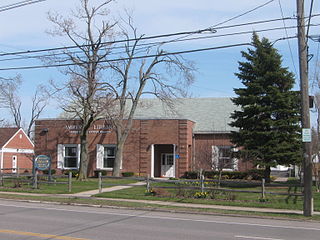
Snyder is a hamlet within the town of Amherst in Erie County, New York, that is part of the Buffalo–Niagara Falls metropolitan area. The hamlet was established in 1837. It was named for Michael Snyder, its first postmaster, who also operated a store at the corner of Harlem Road, which is also known as New York State Route 240, and Main Street, which is also known as New York State Route 5. The hamlet blossomed due to retail activity demand created along the Main Street transportation route between Buffalo and points to the east in the 19th and early 20th century.

Niagara Square is a public square located at the intersections of Delaware Avenue, Court Street, Genesee Street, and Niagara Street in Buffalo, New York. It is the central hub of Joseph Ellicott's original radial street pattern that he designed in 1804 for the then village of New Amsterdam. It continues to be the nexus of downtown Buffalo.

Buffalo is the county seat of Erie County, and the second most populous city in the U.S. state of New York, after New York City. Originating around 1789 as a small trading community inhabited by the Neutral Nation near the mouth of Buffalo Creek, the city, then a town, grew quickly after the opening of the Erie Canal in 1825, with the city at its western terminus. Its position at the eastern end of Lake Erie strengthened the economy, based on grain milling and steel production along the southern shores and in nearby Lackawanna.
Cyrus Lazelle Warner Eidlitz was an American architect best known for designing One Times Square, the former New York Times Building on Times Square. He is founder of the architecture firm presently known as HLW International, one of the oldest architecture firms in the United States.

The Buffalo & Erie County Public Library is located on Lafayette Square, Buffalo, New York, United States. The current facility, designed by James William Kideney & Associates and built in 1964, replaced the original Cyrus Eidlitz Buffalo Public Library Building dedicated in February 1887. The first Buffalo Public Library, in turn, replaced the Erie County, New York courthouse, which occupied the parcel from 1816-1876.

The Southtowns is a region of Western New York, United States, that lies within the snowbelt or ski country. It includes the southern suburbs of Buffalo, New York. This is the common name for the southern part of Erie County, New York.

The Buffalo Metropolitan Transportation Center is located on the southeast corner of North Division and Ellicott Streets in Downtown Buffalo, New York. The transportation center is open 24 hours daily.
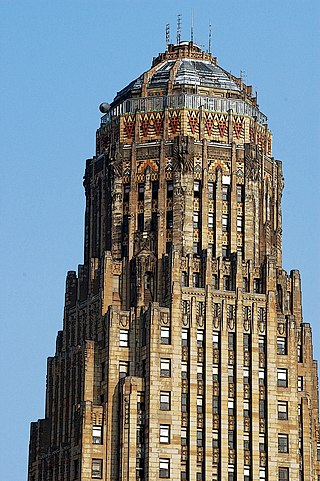
The Architecture of Buffalo, New York, particularly the buildings constructed between the American Civil War and the Great Depression, is said to have created a new, distinctly American form of architecture and to have influenced design throughout the world.
Esenwein & Johnnson was an architectural firm of Buffalo, New York.

Gilbert du Motier, Marquis de Lafayette (1757–1834), a French aristocrat and Revolutionary War hero, was widely commemorated in the U.S. and elsewhere. Below is a list of the many homages and/or tributes named in his honor:

Transportation in Buffalo, New York is dominated by automobile use, but other modes of transportation exist in the city.
